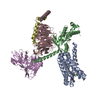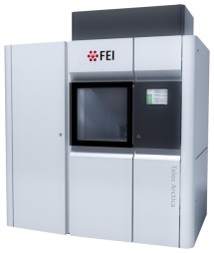+ Open data
Open data
- Basic information
Basic information
| Entry | Database: PDB / ID: 9dqj | ||||||||||||||||||||||||
|---|---|---|---|---|---|---|---|---|---|---|---|---|---|---|---|---|---|---|---|---|---|---|---|---|---|
| Title | CryoEM structure of Gq-coupled MRGPRD with a new agonist EP-3945 | ||||||||||||||||||||||||
 Components Components |
| ||||||||||||||||||||||||
 Keywords Keywords | SIGNALING PROTEIN / GPCR | ||||||||||||||||||||||||
| Function / homology |  Function and homology information Function and homology informationangiotensin-mediated vasodilation involved in regulation of systemic arterial blood pressure / adenylate cyclase-activating serotonin receptor signaling pathway / negative regulation of adenylate cyclase-activating adrenergic receptor signaling pathway / sensory perception of chemical stimulus / negative regulation of calcium ion-dependent exocytosis / G protein-coupled adenosine receptor signaling pathway / negative regulation of adenylate cyclase activity / positive regulation of urine volume / mu-type opioid receptor binding / corticotropin-releasing hormone receptor 1 binding ...angiotensin-mediated vasodilation involved in regulation of systemic arterial blood pressure / adenylate cyclase-activating serotonin receptor signaling pathway / negative regulation of adenylate cyclase-activating adrenergic receptor signaling pathway / sensory perception of chemical stimulus / negative regulation of calcium ion-dependent exocytosis / G protein-coupled adenosine receptor signaling pathway / negative regulation of adenylate cyclase activity / positive regulation of urine volume / mu-type opioid receptor binding / corticotropin-releasing hormone receptor 1 binding / positive regulation of neural precursor cell proliferation / negative regulation of synaptic transmission / G protein-coupled peptide receptor activity / beta-2 adrenergic receptor binding / gamma-aminobutyric acid signaling pathway / regulation of calcium ion transport / negative regulation of apoptotic signaling pathway / PKA activation in glucagon signalling / developmental growth / D1 dopamine receptor binding / neuronal dense core vesicle / Hedgehog 'off' state / positive regulation of vascular associated smooth muscle cell proliferation / positive regulation of superoxide anion generation / Adenylate cyclase inhibitory pathway / response to prostaglandin E / insulin-like growth factor receptor binding / ionotropic glutamate receptor binding / adenylate cyclase regulator activity / response to nutrient / hippocampal mossy fiber to CA3 synapse / adenylate cyclase activator activity / Regulation of insulin secretion / G protein-coupled receptor binding / bone development / G protein-coupled receptor activity / adenylate cyclase-inhibiting G protein-coupled receptor signaling pathway / platelet aggregation / G-protein beta/gamma-subunit complex binding / adenylate cyclase-activating G protein-coupled receptor signaling pathway / Olfactory Signaling Pathway / Activation of the phototransduction cascade / G beta:gamma signalling through PLC beta / Presynaptic function of Kainate receptors / Thromboxane signalling through TP receptor / G protein-coupled acetylcholine receptor signaling pathway / Activation of G protein gated Potassium channels / Inhibition of voltage gated Ca2+ channels via Gbeta/gamma subunits / G-protein activation / Prostacyclin signalling through prostacyclin receptor / G beta:gamma signalling through CDC42 / Glucagon signaling in metabolic regulation / G beta:gamma signalling through BTK / Synthesis, secretion, and inactivation of Glucagon-like Peptide-1 (GLP-1) / ADP signalling through P2Y purinoceptor 12 / photoreceptor disc membrane / Sensory perception of sweet, bitter, and umami (glutamate) taste / Glucagon-type ligand receptors / Adrenaline,noradrenaline inhibits insulin secretion / Vasopressin regulates renal water homeostasis via Aquaporins / Glucagon-like Peptide-1 (GLP1) regulates insulin secretion / G alpha (z) signalling events / cellular response to catecholamine stimulus / ADORA2B mediated anti-inflammatory cytokines production / ADP signalling through P2Y purinoceptor 1 / G beta:gamma signalling through PI3Kgamma / Cooperation of PDCL (PhLP1) and TRiC/CCT in G-protein beta folding / adenylate cyclase-activating dopamine receptor signaling pathway / GPER1 signaling / Inactivation, recovery and regulation of the phototransduction cascade / cellular response to prostaglandin E stimulus / G-protein beta-subunit binding / heterotrimeric G-protein complex / G alpha (12/13) signalling events / sensory perception of taste / extracellular vesicle / positive regulation of cold-induced thermogenesis / signaling receptor complex adaptor activity / Thrombin signalling through proteinase activated receptors (PARs) / retina development in camera-type eye / G protein activity / cell body / GTPase binding / Ca2+ pathway / fibroblast proliferation / midbody / High laminar flow shear stress activates signaling by PIEZO1 and PECAM1:CDH5:KDR in endothelial cells / G alpha (i) signalling events / G alpha (s) signalling events / phospholipase C-activating G protein-coupled receptor signaling pathway / G alpha (q) signalling events / Hydrolases; Acting on acid anhydrides; Acting on GTP to facilitate cellular and subcellular movement / Ras protein signal transduction / Extra-nuclear estrogen signaling / cell population proliferation / positive regulation of ERK1 and ERK2 cascade / positive regulation of cell migration / ciliary basal body / apical plasma membrane / G protein-coupled receptor signaling pathway Similarity search - Function | ||||||||||||||||||||||||
| Biological species |  Homo sapiens (human) Homo sapiens (human) | ||||||||||||||||||||||||
| Method | ELECTRON MICROSCOPY / single particle reconstruction / cryo EM / Resolution: 2.9 Å | ||||||||||||||||||||||||
 Authors Authors | Cao, C. / Wang, C. / Liu, Y. / Fay, J.F. / Roth, B.L. | ||||||||||||||||||||||||
| Funding support |  United States, 2items United States, 2items
| ||||||||||||||||||||||||
 Citation Citation |  Journal: Cell Rep / Year: 2024 Journal: Cell Rep / Year: 2024Title: High-affinity agonists reveal recognition motifs for the MRGPRD GPCR. Authors: Chunyu Wang / Yongfeng Liu / Marion Lanier / Adam Yeager / Isha Singh / Ryan H Gumpper / Brian E Krumm / Chelsea DeLeon / Shicheng Zhang / Marcus Boehm / Richard Pittner / Alain Baron / Lisa ...Authors: Chunyu Wang / Yongfeng Liu / Marion Lanier / Adam Yeager / Isha Singh / Ryan H Gumpper / Brian E Krumm / Chelsea DeLeon / Shicheng Zhang / Marcus Boehm / Richard Pittner / Alain Baron / Lisa Dvorak / Corinne Bacon / Brian K Shoichet / Esther Martinborough / Jonathan F Fay / Can Cao / Bryan L Roth /   Abstract: The human MRGPRD protein is a member of the Mas-related G protein-coupled receptors (MRGPRs) that is involved in the sensing of pain, itch, and other inflammatory stimuli. As with other MRGPRs, ...The human MRGPRD protein is a member of the Mas-related G protein-coupled receptors (MRGPRs) that is involved in the sensing of pain, itch, and other inflammatory stimuli. As with other MRGPRs, MRGPRD is a relatively understudied receptor with few known agonists. The most potent small-molecule agonist of MRGPRD reported so far is β-alanine, with an affinity in the micromole range, which largely restricts its functional study. Here, we report two MRGPRD agonists, EP-2825 and EP-3945, that are approximately 100-fold more potent than β-alanine and determine the structures of MRGPRD-Gq in complex with EP-2825 and EP-3945, respectively. The structures reveal distinct agonist binding modes of MRGPRD and large conformational plasticity of the orthosteric pocket. Collectively, the discovery of high-affinity MRGPRD agonists and their distinct binding modes will facilitate the functional study and the structure-based design of ligands targeting this understudied receptor. | ||||||||||||||||||||||||
| History |
|
- Structure visualization
Structure visualization
| Structure viewer | Molecule:  Molmil Molmil Jmol/JSmol Jmol/JSmol |
|---|
- Downloads & links
Downloads & links
- Download
Download
| PDBx/mmCIF format |  9dqj.cif.gz 9dqj.cif.gz | 200.3 KB | Display |  PDBx/mmCIF format PDBx/mmCIF format |
|---|---|---|---|---|
| PDB format |  pdb9dqj.ent.gz pdb9dqj.ent.gz | Display |  PDB format PDB format | |
| PDBx/mmJSON format |  9dqj.json.gz 9dqj.json.gz | Tree view |  PDBx/mmJSON format PDBx/mmJSON format | |
| Others |  Other downloads Other downloads |
-Validation report
| Summary document |  9dqj_validation.pdf.gz 9dqj_validation.pdf.gz | 1.2 MB | Display |  wwPDB validaton report wwPDB validaton report |
|---|---|---|---|---|
| Full document |  9dqj_full_validation.pdf.gz 9dqj_full_validation.pdf.gz | 1.2 MB | Display | |
| Data in XML |  9dqj_validation.xml.gz 9dqj_validation.xml.gz | 46.9 KB | Display | |
| Data in CIF |  9dqj_validation.cif.gz 9dqj_validation.cif.gz | 70.5 KB | Display | |
| Arichive directory |  https://data.pdbj.org/pub/pdb/validation_reports/dq/9dqj https://data.pdbj.org/pub/pdb/validation_reports/dq/9dqj ftp://data.pdbj.org/pub/pdb/validation_reports/dq/9dqj ftp://data.pdbj.org/pub/pdb/validation_reports/dq/9dqj | HTTPS FTP |
-Related structure data
| Related structure data |  47114MC  9dqhC M: map data used to model this data C: citing same article ( |
|---|---|
| Similar structure data | Similarity search - Function & homology  F&H Search F&H Search |
- Links
Links
- Assembly
Assembly
| Deposited unit | 
|
|---|---|
| 1 |
|
- Components
Components
-Guanine nucleotide-binding protein ... , 3 types, 3 molecules BCD
| #2: Protein | Mass: 28084.832 Da / Num. of mol.: 1 Source method: isolated from a genetically manipulated source Source: (gene. exp.)  Homo sapiens (human) / Gene: GNAI2, GNAI2B, GNAS, GNAS1 / Production host: Homo sapiens (human) / Gene: GNAI2, GNAI2B, GNAS, GNAS1 / Production host:  References: UniProt: P04899, UniProt: Q5JWF2, Hydrolases; Acting on acid anhydrides; Acting on GTP to facilitate cellular and subcellular movement |
|---|---|
| #3: Protein | Mass: 37728.152 Da / Num. of mol.: 1 Source method: isolated from a genetically manipulated source Source: (gene. exp.)  Homo sapiens (human) / Gene: GNB1 / Production host: Homo sapiens (human) / Gene: GNB1 / Production host:  |
| #4: Protein | Mass: 7861.143 Da / Num. of mol.: 1 Source method: isolated from a genetically manipulated source Source: (gene. exp.)  Homo sapiens (human) / Gene: GNG2 / Production host: Homo sapiens (human) / Gene: GNG2 / Production host:  |
-Protein / Antibody / Non-polymers , 3 types, 3 molecules AE
| #1: Protein | Mass: 36171.523 Da / Num. of mol.: 1 Source method: isolated from a genetically manipulated source Source: (gene. exp.)  Homo sapiens (human) / Gene: MRGPRD, MRGD / Production host: Homo sapiens (human) / Gene: MRGPRD, MRGD / Production host:  |
|---|---|
| #5: Antibody | Mass: 27409.588 Da / Num. of mol.: 1 Source method: isolated from a genetically manipulated source Source: (gene. exp.)   |
| #6: Chemical | ChemComp-A1BEQ / Mass: 418.488 Da / Num. of mol.: 1 / Source method: obtained synthetically / Formula: C24H26N4O3 / Feature type: SUBJECT OF INVESTIGATION |
-Details
| Has ligand of interest | Y |
|---|---|
| Has protein modification | Y |
-Experimental details
-Experiment
| Experiment | Method: ELECTRON MICROSCOPY |
|---|---|
| EM experiment | Aggregation state: PARTICLE / 3D reconstruction method: single particle reconstruction |
- Sample preparation
Sample preparation
| Component |
| ||||||||||||||||||||||||||||||||||||||||||
|---|---|---|---|---|---|---|---|---|---|---|---|---|---|---|---|---|---|---|---|---|---|---|---|---|---|---|---|---|---|---|---|---|---|---|---|---|---|---|---|---|---|---|---|
| Molecular weight | Value: 0.137 MDa / Experimental value: NO | ||||||||||||||||||||||||||||||||||||||||||
| Source (natural) |
| ||||||||||||||||||||||||||||||||||||||||||
| Source (recombinant) |
| ||||||||||||||||||||||||||||||||||||||||||
| Buffer solution | pH: 7.4 | ||||||||||||||||||||||||||||||||||||||||||
| Specimen | Embedding applied: NO / Shadowing applied: NO / Staining applied: NO / Vitrification applied: YES | ||||||||||||||||||||||||||||||||||||||||||
| Vitrification | Cryogen name: ETHANE-PROPANE |
- Electron microscopy imaging
Electron microscopy imaging
| Experimental equipment |  Model: Talos Arctica / Image courtesy: FEI Company |
|---|---|
| Microscopy | Model: FEI TALOS ARCTICA |
| Electron gun | Electron source:  FIELD EMISSION GUN / Accelerating voltage: 200 kV / Illumination mode: FLOOD BEAM FIELD EMISSION GUN / Accelerating voltage: 200 kV / Illumination mode: FLOOD BEAM |
| Electron lens | Mode: BRIGHT FIELD / Nominal defocus max: 3000 nm / Nominal defocus min: 200 nm |
| Image recording | Electron dose: 56.9 e/Å2 / Film or detector model: GATAN K3 (6k x 4k) |
- Processing
Processing
| EM software |
| ||||||||||||
|---|---|---|---|---|---|---|---|---|---|---|---|---|---|
| CTF correction | Type: PHASE FLIPPING AND AMPLITUDE CORRECTION | ||||||||||||
| Symmetry | Point symmetry: C1 (asymmetric) | ||||||||||||
| 3D reconstruction | Resolution: 2.9 Å / Resolution method: FSC 0.143 CUT-OFF / Num. of particles: 318286 / Symmetry type: POINT |
 Movie
Movie Controller
Controller




 PDBj
PDBj





























